Ruediger Beckmann
Ruediger Beckmann è un fotografo tedesco che vive e lavora ad Amburgo. La sua ricerca fotografica verte essenzialmente sull’identità femminile, e si basa sulla collaborazione con modelle. Tuttavia, i suoi ritratti femminili si discostano notevolmente dai cliché più diffusi nella fotografia glamour, pubblicitaria e di moda. Si tratta di immagini molto personali, intime, che sembrano nascere, come ne L’insostenibile leggerezza dell’essere di Kundera, da una costante ricerca delle impercettibili differenze esistenti tra una donna e l’altra. Di questo ed altro abbiamo parlato con Ruediger nell’intervista che ci ha gentilmente concesso.
(English version below – Deutsche Übersetzung here)
IIBN: «Prima di tutto, ci piacerebbe sapere qualcosa in più su di te. Abbiamo letto sul tuo sito che hai iniziato a lavorare come grafico, per poi diventare invece un fotografo professionista. Come è avvenuto questo cambiamento nella tua vita?»
RB: «Lavoro ancora come grafico, ma la fotografia occupa una parte sempre più cospicua del mio tempo. Ho comunque deciso di evitare di rendere il guadagno economico il principale obiettivo della mia passione per la fotografia, perché voglio che la mia attività di fotografo rimanga quanto più indipendente possibile. Ci sono persone che riescono a trasformare la loro passione in una carriera, ma ho visto già troppi fotografi il cui stile è stato condizionato dalla possibilità di lavorare in determinati mercati. Non voglio prendere decisioni (“Che immagini dovrei scattare?”) in base ad un tornaconto economico. Le arti devono prosperare liberamente.»
IIBN: «Tu lavori con delle modelle. Cosa cerchi in una modella? Quali aspetti dell’essere donna cerchi di mettere in risalto tramite il tuo lavoro fotografico?»
RB: «Fondamentalmente, sono in cerca di un’emozione credibile. E’ complicato per me spiegare a una nuova modella cosa cerco e quali sono i miei obiettivi. Loro possono vedere dalle migliaia di fotografie che ho scattato com’è andata con altre modelle, ma ovviamente non sanno come andrà nel loro caso. Non posso davvero sapere in anticipo se una persona è adatta a me o no. Possiamo solo scoprirlo attraverso una sessione di scatti, e questo è abbastanza complicato, come si può immaginare, perché le persone sono molto diverse l’una dall’altra. La cosa più importante per una buona sessione fotografica è una base di onestà e condivisione. Entrambi mettiamo in gioco una parte di noi stessi, e le immagini riflettono questo incontrarsi.
Mi è stato chiesto altre volte perché attualmente non fotografo uomini. Ho fatto alcuni tentativi, ma ho scoperto che gli uomini non sono molto a loro agio nei miei confronti, nei confronti dell’energia che viene sprigionata da questo aprirsi e affidarsi l’un l’altro a questo livello molto personale ed emotivo che ricerco sempre. Penso che molta della nostra energia naturale venga dal gioco dell’accoppiamento e dello stare insieme. Gli uomini sono interessati alle donne, e viceversa, e questo è naturale se sei eterosessuale. Io trovo che le donne siano attraenti e affascinanti e, anche se il mio obiettivo non è principalmente sessuale, penso che ci sia comunque una componente sensuale a cui sessi opposti reagiscono meglio poiché è quello che abbiamo imparato a fare in tutta la nostra vita. Immagino che fotografie di uomini simili a quelle che io scatto alle donne, probabilmente esistano, scattate da donne.»
IIBN: «Dalle tue immagini emerge un senso di intimità tra te e le donne che fotografi, che di solito è difficile da creare quando si lavora con delle modelle, specialmente in studio. Questo senso di intimità, a nostro parere, rende i tuoi ritratti molto differenti dai ritratti di donne che siamo abituati a vedere nella fotografia pubblicitaria e di moda. Quanto di ciò che scatti è stabilito in partenza? Stabilisci i dettagli in anticipo, anche discutendoli con le tue modelle?»
RB: «Questa intimità non è affatto precostruita, succede e basta. Di solito scatto sempre negli stessi posti, la mia cucina, la mia doccia, la mia mansarda, o le loro stanze. L’ambiente familiare contribuisce a creare un’atmosfera accogliente, che è la premessa più importante per la buona riuscita di una sessione di scatti.
Molto raramente ho un tema specifico o delle intenzioni visive per le immagini da scattare, a meno che la modella non esprima il desiderio di affrontare un determinato tema. Cerco di cancellare dalla mia mente tutte le altre immagini prima di iniziare a scattare. Ascolto semplicemente lo stato d’animo della modella e le sue impressioni e provo ad affidarmi, con lei, alle nostre intuizioni.
Ascoltiamo la musica, parliamo, magari beviamo qualcosa, e dopo un po’ lei si rilassa e, in modo del tutto spontaneo, inizia a stabilirsi un flusso di comunicazione tra noi. Riesco a percepire lo stato d’animo della mia modella. Raramente sistemo o correggo qualcosa, perché significherebbe iniziare di nuovo a pensare, e il cervello di solito prevale sull’intuizione. Penso invece che la cosa migliore sia lasciare la mente fuori da questo processo, per quanto mi è possibile.
Quando ci si sente bene, le immagini saranno buone in ogni caso.»
IIBN: «Si potrebbe pensare che la comunicazione che tra il fotografo e i suoi modelli o modelle prima della sessione fotografica sia qualcosa di inutile, persino pretenzioso. Non pensi che questo possa invece essere il modo migliore di coinvolgere le modelle e permettere loro di esprimere la loro vera natura, magari così da far emergere addirittura qualche segreto, che non sarebbe possibile rappresentare o vedere in altri modi? O, al contrario, pensi che ciò che è fondamentale in una sessione di ritratto è rappresentare la personalità della modella come lei la esprime normalmente e solitamente?»
RB: «Dipende tutto da ciò che si sta cercando. L’argomento della mia tesi di diploma, incompiuta, era “Eigenbild vs. Fremdbild”, che si può tradurre più o meno come “immagine di sè e immagine pubblica” o “la nostra idea di noi stessi e la percezione che gli altri hanno di noi”. Essere fotografati in genere è qualcosa che riguarda le apparenze. Che aspetto ho, come appaio, chi sono, chi devo essere, chi posso essere? In che modo la mia immagine di me stesso si riflette nel mio aspetto?
Ognuno di noi ha tattiche differenti per affrontare la vita. Alcuni sono troppo timidi, altri sono stranamente fiduciosi nel loro aspetto fisico, ognuno ha priorità diverse a seconda della propria storia, e ognuno lavora in questa direzione ogni giorno. Scoprire qualcosa riguardo a questa “lotta” mi fornisce un vasto campo di osservazione. Il mio compito più importante è ascoltare, riuscire a conoscere davvero la persona per com’è dentro e rispettarla per tutto ciò che è.
Questo è l’inizio di un viaggio, in cui la modella esplora il suo modo migliore di esprimersi.
Alcune modelle amano essere osservate mentre esplorano il loro universo personale, altre vogliono essere corteggiate, ad altre ancora piace combattere, mentre c’è chi preferisce collaborare in base alle idee che condividiamo conversando, e chi vuole invece rimanere avvolta dal mistero.
Per me l’idea di un buon ritratto consiste, allo stesso tempo, nel non svelare troppo della vera personalità del soggetto e nel non mostrare qualcosa che lei non è. Una sessione di scatti è sempre un gioco, un gioco in cui si creano delle opportunità, e a volte il risultato si rivela lusinghiero o eccitante o spaventoso o strano, ma in esso c’è sempre un po’ di verità.
Ecco perché questo tipo di fotografia causa forte dipendenza.
A volte temo che le fotografie non siano la parte più importante di questa esperienza. E’ un viaggio. Quando questa energia si manifesta, se ne vuole trovare sempre di più.»
IIBN: «Le tue serie di ritratti femminili ci sembrano ispirate da L’insostenibile leggerezza dell’essere di Kundera, il cui protagonista, attraverso il sesso, ricerca ossessivamente la differenza, a volte impercettibile, che c’è tra una donna e un’altra. La tua ricerca fotografica ha qualcosa a che vedere con l’opera di Kundera?»
RB: «Non ci avevo mai pensato, ma probabilmente avete assolutamente ragione. Mentre per altri fotografi la ricerca culmina spesso con l’incontro con una controparte quasi perfetta, che diventa la loro musa, io amo particolarmente la ricerca delle differenze che ci sono tra le varie persone che ritraggo. Ma non si tratta solo di questo. Superare insieme le prime tensioni, andare oltre la naturale prudenza per poi alla fine dimostrare fiducia e dedizione e di conseguenza aprirsi e impegnarsi l’uno con l’altra, insieme, è probabilmente una delle ragioni per cui continuo a ripetere questa esperienza.
Sono tuttora molto sorpreso di aver raggiunto questo livello di comprensione e fiducia con così tante persone diverse tra loro.»
IIBN: «I tuoi scatti sono realizzati su pellicola, soprattutto in medio formato. In che modo questa scelta influisce sul tuo modo di fotografare e sui risultati che ottieni?»
RB: «Le macchine medio formato si sono rivelate un ottimo strumento in questo tipo di situazione, perché guardando la modella direttamente nel pozzetto posso davvero percepire l’immagine mentre prende forma. Non amo nè i monitor nè i mirini perché sono troppo piccoli e permettono una percezione troppo poco diretta.
Ho provato tutti i supporti, ma finché c’è pellicola la userò sempre. Quando ho iniziato a fotografare, spesso ho dovuto confrontarmi con insegnanti che erano convinti che bisognerebbe sempre avere il controllo del proprio equipaggiamento tecnico e cercare di ottenere una qualità immacolata, la migliore possibile. Ma io trovavo noiose le loro immagini perfette e mi piaceva molto ciò che accadeva con gli errori che possono venir fuori su pellicola o con macchine fotografiche difettose.
Una volta mi è caduta la mia toy-camera Action Sampler nel fiume, sono riuscito a ripescarla ed ho scattato le foto che rimanevano. Il fiume aveva iniziato a sviluppare alcune parti della pellicola, con risultati fantastici e assolutamente irripetibili. Probabilmente per qualcuno si tratta di effetti grossolani, ma per me in essi c’è molto di più. Questi affascinanti incidenti mi hanno insegnato che è bellissimo perdere il controllo. Se ci si aggrappa troppo forte alle proprie opinioni e alla propria abilità tecnica, si scatteranno immagini che possono solo riflettere ciò che si ha in testa. Ma nel mondo, là fuori, c’è molto di più di questo.
Gli errori e le coincidenze continuano a ispirarmi e mi permettono di espandere le mie visioni. Perché non è detto che non commettere errori sia sufficiente ad ottenere il giusto risultato.»
Vi invitiamo a visitare il sito di Ruediger Beckmann e il suo spazio su Flickr, dove è presente come pixelwelten. Segue la versione originale dell’intervista, in inglese.
IIBN: «First of all, we would like to know something more about you. We’ve read on your website that you started working as a graphic designer and you are now a professional photographer. How did this change come about in your life?»
RB: «I still work as a graphic designer, but photography is taking over more and more of my time. Still, I have decided not to make money the prime object of my passion because I want to keep things as independent as possible. Some people succeed in pursuing their passion as a career, but I have seen too many photographers whose style has been influenced by their prospective markets. I don’t want to make decisions (what pictures do i take?) based on economics. The arts need to be free to thrive.»
IIBN: «You work with female models. What do you look for in a model? What aspects of being a woman do you seek to emphasise through your photographic work?»
RB: «Basically, I want to find a credible emotion. I have problems explaining to new models what I look for and what my goals are. From thousands of pictures they see what has happened with others, but of course they don’t know what can happen with them. I cannot really answer in advance whether a person is suitable for me or not. we can only experience a shooting to find it out, and this is rather difficult, as you can imagine, because all people are so different. Most important for a good session is a basis of honesty and sharing. We both put a part of ourselves on the line, and the pictures reflect where we intersected.
I have been asked why I don’t shoot pictures of men right now. I have tried a few times, but I find that men are not very comfortable towards me with the energy that comes along with the opening and trusting on this very personal emotional level that I always seek. I think a lot of our natural energy comes from the mating and the dating game. Men are interested in women, and vice versa, that’s natural when you are straight. I find women attractive and appealing, and even as my objective is not primarily a sexual one I think there is still a sensual component which the opposite sexes respond to better because we have learned to do so all our lives. I expect that comparable pictures of men will probably be taken by women.»
IIBN: «There appears to be a sense of intimacy between you and your models, which is usually difficult to create when shooting with models, especially in a studio. This sense of intimacy, we believe, makes your portraits much different from commercial and fashion portraits of women. How much of what you shoot is pre-determined? Do you arrange every detail in advance, also discussing with your models?»
RB: «This intimacy is not at all arranged, it just happens. I usually shoot at the same locations, my kitchen, my shower, my attic, or their rooms. This familiar environment helps in creating a comfortable atmosphere, which is the most important premise for a good shooting.
I very rarely have a specific theme or optical intention for the pictures unless the model wants to tackle a certain subject. I try to clear all images in my head before the shooting. I just listen to the mood the models bring along and try to trust in our intuition.
We listen to music, talk, maybe have a drink or two, and after a while she relaxes and some kind of flow start to happen of its own accord. I get a feeling for the mood my model is in. I rarely arrange or correct, because then you start to think again, and the brain usually overpowers the intuition. I find it’s best to keep the head out of this process as much as I possibly can.
When you feel right, the picture is going to be all right, anyway.»
IIBN: «Some might think that communication between model and photographer before the shooting session is something useless, even pretentious. Don’t you think that this might instead be the best way to involve the models and let them express their real nature, even letting some secret be revealed, which would not be representable and visible in other ways? Or, in contrast, do you think what it is fundamental in a portrait session is to represent the models’ personality as they normally, usually express it?»
RB: «It all depends on what you are looking for. The subject of my (unfinished) diploma thesis was “Eigenbild vs. Fremdbild”, roughly translated as “self-image vs. public image” or “our self-concept vs. the perception by others”. Being photographed is usually about appearances. What do I look like, how do I appear, what am I, what must I be, what can I be? How does my self-image reflect on my appearance?
We all have different tactics going through life. Some are all too shy, some are strangely confident with their appearance, everyone has a different agenda based on their history, and everyone works on this subject every day. Getting to know a little bit of this struggle offers a wide field for me to observe. My most important task is to listen, to really get to know the person inside and to respect her for all that she is.
This is the beginning of a journey, where the model explores her best way of expressing herself.
Some models like to be watched exploring their own universe, some like to be courted, some like to fight, some like to cooperate based on ideas that we share in conversation, some like to remain a mystery.
For me the idea of a good portrait is neither to expose too much of her true personality nor to show something that she is not. a shooting is always a game, a game to create opportunities, and sometimes you find the turnout to be flattering or thrilling or frightening or strange, but there is always some truth in it.
That’s why this kind of photography is highly addictive.
Sometimes I fear that the pictures are not the most important part of this experience. It’s a trip. You always want to find more of that energy when it visualizes.»
IIBN: «Your series of female portraits seem to us to be inspired by Kundera’s The Unbearable Lightness of Being, whose protagonist, through sex, obsessively looks for the difference, at times imperceptible, between a woman and another. Has your photographic research something to do with Kundera’s work?»
RB: «This thought never occured to me, but you are possibly very right. Whereas the search of other photographers often culminates in one almost perfect counterpart, their muse, I particularly like to find the differences in the various people i portray. but it’s not only that. Overcoming the first tensions together, getting past the natural prudence to finally show trust and dedication and as a result experiencing the openness and commitment together is possibly one of the reasons I do all this over and over again.
I am still very surprised that i have achieved this level of understanding and confidence with so many different people.»
IIBN: «You shoot film and use medium format cameras. In what ways does this choice affect the way you shoot and the results you obtain?»
RB: «Medium format cameras have proven to be good companions because when regarding the model directly through the light well (Lichtschacht) I can really feel the picture as it happens. I am not a friend of neither displays nor viewfinders as they are too small and far too indirect to feel.
I have tried all kinds of media, but as long as there is film I will always use it. When I started I often had to face teachers who were convinced that you should always be in control of your equipment and strive towards the best possible immaculate quality. But I found their perfect pictures to be boring and I particularly liked what happened with errors on film and by faulty cameras.
By accident I threw my action sampler into the river once, fished it out and shot the remaining pictures. The results of the river pre-developing parts of it were great and absolutely non-repeatable. You may think that these are cheap effects, but for me it goes far beyond that. These attractive mishaps have tought me that it’s great to lose control. If you cling to your opinions and skills too tightly your pictures can only reflect what’s on your mind. but there is so much more out there.
Mistakes and coincidences keep on inspiring and expanding my vision.
Because not doing anything wrong doesn’t make it right.»

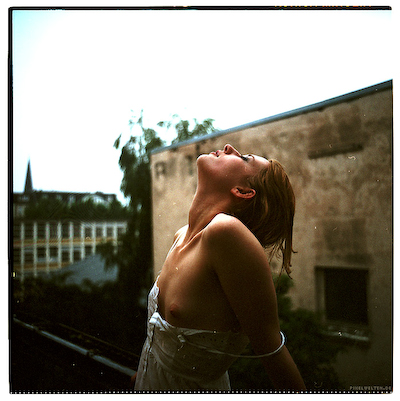




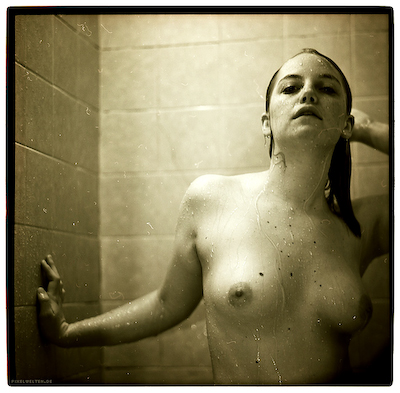

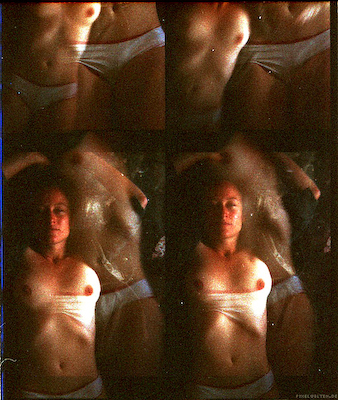
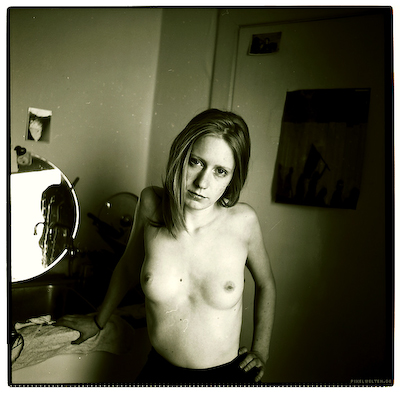

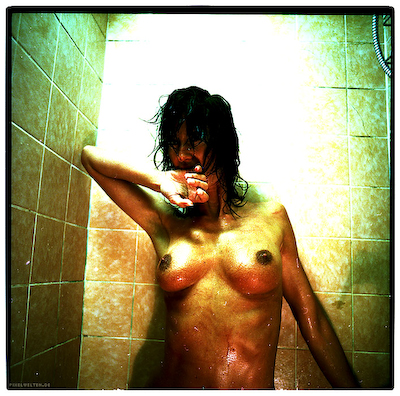


5 settembre 2008 a 14:59
Complimenti a voi per l’intervista e a lui per le risposte e le foto. Ma soprattutto ben tornati dalla pausa estiva.
18 luglio 2009 a 20:07
[…] Here’s and Italian article about him: Ruediger Beckmann « Idee in Bianco e Nero […]
20 settembre 2010 a 05:08
[…] Ein weiteres Intervie findet ihr hier: in Deutsch – in italienisch […]